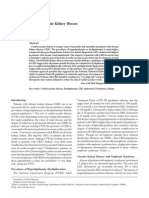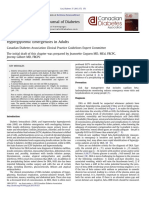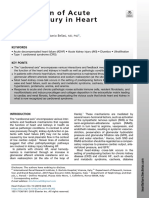0 ratings0% found this document useful (0 votes)
8 Meq/L PH 7.2) May Require Iv Therapy (See Chap. 51) .: Evaluation of Therapeutic Outcomes
8 Meq/L PH 7.2) May Require Iv Therapy (See Chap. 51) .: Evaluation of Therapeutic Outcomes
Uploaded by
DebbyNovriozaThe document discusses treatment of metabolic acidosis through administration of oral or intravenous bicarbonate salts. It notes that doses must be titrated to maintain normal plasma bicarbonate concentrations and higher doses may be required for patients with renal tubular acidosis. Careful monitoring of fluid balance and electrolytes is needed to avoid complications like alkalosis. Regular monitoring of blood gases and electrolytes is also necessary to determine treatment effectiveness and avoid overcorrection.
Copyright:
© All Rights Reserved
Available Formats
Download as DOC, PDF, TXT or read online from Scribd
Download as doc, pdf, or txt
8 Meq/L PH 7.2) May Require Iv Therapy (See Chap. 51) .: Evaluation of Therapeutic Outcomes
8 Meq/L PH 7.2) May Require Iv Therapy (See Chap. 51) .: Evaluation of Therapeutic Outcomes
Uploaded by
DebbyNovrioza0 ratings0% found this document useful (0 votes)
The document discusses treatment of metabolic acidosis through administration of oral or intravenous bicarbonate salts. It notes that doses must be titrated to maintain normal plasma bicarbonate concentrations and higher doses may be required for patients with renal tubular acidosis. Careful monitoring of fluid balance and electrolytes is needed to avoid complications like alkalosis. Regular monitoring of blood gases and electrolytes is also necessary to determine treatment effectiveness and avoid overcorrection.
Original Description:
jygku
Original Title
A4
Copyright
© © All Rights Reserved
Available Formats
DOC, PDF, TXT or read online from Scribd
Share this document
Did you find this document useful?
Is this content inappropriate?
The document discusses treatment of metabolic acidosis through administration of oral or intravenous bicarbonate salts. It notes that doses must be titrated to maintain normal plasma bicarbonate concentrations and higher doses may be required for patients with renal tubular acidosis. Careful monitoring of fluid balance and electrolytes is needed to avoid complications like alkalosis. Regular monitoring of blood gases and electrolytes is also necessary to determine treatment effectiveness and avoid overcorrection.
Copyright:
© All Rights Reserved
Available Formats
Download as DOC, PDF, TXT or read online from Scribd
Download as doc, pdf, or txt
0 ratings0% found this document useful (0 votes)
8 Meq/L PH 7.2) May Require Iv Therapy (See Chap. 51) .: Evaluation of Therapeutic Outcomes
8 Meq/L PH 7.2) May Require Iv Therapy (See Chap. 51) .: Evaluation of Therapeutic Outcomes
Uploaded by
DebbyNovriozaThe document discusses treatment of metabolic acidosis through administration of oral or intravenous bicarbonate salts. It notes that doses must be titrated to maintain normal plasma bicarbonate concentrations and higher doses may be required for patients with renal tubular acidosis. Careful monitoring of fluid balance and electrolytes is needed to avoid complications like alkalosis. Regular monitoring of blood gases and electrolytes is also necessary to determine treatment effectiveness and avoid overcorrection.
Copyright:
© All Rights Reserved
Available Formats
Download as DOC, PDF, TXT or read online from Scribd
Download as doc, pdf, or txt
You are on page 1/ 2
prevent
volume overload from excessive sodium intake. After the serum
bicarbonate has normalized, a maintenance regimen of bicarbonate
to neutralize daily acid production may be all that is necessary (12 to
20 mEq/day in divided doses). Doses are subsequently titrated to
maintain normal plasma bicarbonate concentrations. Patients with renal
tubular acidosis may require higher doses of alkalinizing agents
(see Chap. 51). Fluid balance should be monitored carefully because
of the sodium content of these agents. Citrate-containing solutions
should not be used in combination with aluminum-containing compounds
because they can enhance aluminum absorption and increase
the risk of aluminum intoxication. Excessive doses of alkalinizing
agents may cause metabolic alkalosis, as well as lethargy or cardiac
depression secondary to a decrease in ionized serum calcium
concentration. Gastrointestinal distress characterized by gastric distention
and flatulence is relatively common with high doses of oral
sodium bicarbonate. Patients with severe acidosis (serum bicarbonate
<8 mEq/L; pH <7.2) may require IV therapy (see Chap. 51).
Metabolic acidosis in both adult and pediatric patients undergoing
dialysis can often be managed by using higher concentrations of
bicarbonate or acetate in the dialysate (>38 mEq/L bicarbonate is safe
and effective). Administration of oral bicarbonate salts as described
above may also be necessary for some patients.
Tromethamine (tris-hydroxymethyl aminomethane) and Carbicarb
(sodium carbonate and sodium bicarbonate) are alternative
alkalinizing agents that have been evaluated for treatment of more
severe acidemia. There are extremely limited data regarding their use
in patients with CKD, which precludes their use in this population. 108
_ EVALUATION OF THERAPEUTIC OUTCOMES
Regular monitoring of arterial blood gases and serum electrolytes are
necessary to determine the effectiveness of therapy. A gradual correction
is appropriate to avoid overcorrection and subsequent complications
such as alkalosis and other electrolyte abnormalities (see
Chap. 51). Laboratory measurement of serum bicarbonate is associated
with several technical problems. Blood collection techniques,
transportation, and assay methodology can affect the measured concentrations.
Blood samples should not have contact with air; process
delays should be avoided; and consistent analytical methods should
be used with serial measurements to improve accuracy. 16
_ TREATMENT OF CARDIOVASCULAR DISEASE IN CKD
Mortality secondary to cardiovascular disease is 10 to 30 times
greater in dialysis patients than in the general population. 9 In addition
to traditional cardiac risk factors such as diabetes, hypertension,
hyperlipidemia, tobacco use, and physical inactivity, patients with
kidney disease have other unique risk factors. Among these are hyperhomocysteinemia,
elevated levels of C-reactive protein, increased oxidant
stress, and hemodynamic overload. 109 Complications previously
discussed such as anemia and metabolic disorders of CKD are also
contributory. In particular, arterial vascular disease (i.e., atherosclerosis)
and cardiomyopathy are the primary types of cardiovascular
disorders present in the CKD population. 9 These disorders lead to development
of ischemic heart disease and its manifestations including
myocardial infarction. As a predominant comorbidity, cardiovascular
disorders and their sequela are the leading cause of death in the ESKD
population.3,5
_ ETIOLOGY AND EPIDEMIOLOGY
_ Hypertension
As a primary cause or a consequence of progressive loss of kidney
function, hypertension is prevalent in the majority of patients with
Stage 3 or 4 CKD (see Chap. 43). Approximately 80% to 90% of
patients initiating dialysis are hypertensive. 110 The pathogenesis of
hypertension in CKD is multifactorial, but in many hypertensive dialysis
patients, fluid retention is a major contributor. 110 In addition to
the general pathophysiologic mechanisms responsible for the development
of hypertension, patients with ESKD may also have increased
sympathetic activity, the presence of an endogenous digitalis-like
substance, elevated levels of endothelin-1, erythropoietin use, hyperparathyroidism,
and structural changes in the arteries (e.g., metastatic
calcification) as contributing factors.110
Patients withESKDalso display an abnormal diurnal blood pressure
rhythm as evidenced by the fact that their blood pressure does not
decrease during the nighttime hours.110 It is unclear what causes this
disturbance in the diurnal rhythm, but this nondipping phenomenon
indicates sustained elevations in blood pressure are present over a prolonged
period of time when compared to the general population.
_ Hyperlipidemia
CKD with or without nephrotic syndrome is frequently accompanied
by abnormalities in lipoprotein metabolism. It is well established
that dyslipidemias cause atherosclerotic cardiovascular disease
and there are many compelling reasons to aggressively treat these
disorders.111 A clear association between hypercholesterolemia, hypertriglyceridemia,
or other lipoprotein changes in patients with CKD
and the high incidence of cardiovascular disease has not been demonstrated
in large prospective studies. However, it is likely that the same
lipoprotein abnormalities that confer increased risk of cardiovascular
disease in the general population would also be harmful to patients
with kidney disease. A low or declining serum cholesterol in patients
with ESKD is also indicative of malnutrition and is associated with
increased mortality.16 Thus a fine balance must be struck to optimize
patient outcomes.
The few epidemiologic studies in CKD patients with nephrotic
syndrome suggest that their relative risk of coronary death or myocardial
infarction is higher than that of matched controls. 112 Similar
analyses have been done in CKD patients without nephrotic syndrome
and in patients on dialysis; low HDL, high triglycerides, high
apolipoprotein B, and high lipoprotein (a) were all associated with
a higher risk of cardiovascular disease. 112 The findings are not uniform,
as hypertriglyceridemia alone has not been shown to be a strong
independent risk factor for coronary heart disease in patients with normal
kidney function.111 However, hypertriglyceridemia may reduce
levels of protective HDL, which is now classified as a major risk
factor for coronary heart disease. Based on these findings and the high
prevalence of atherosclerotic cardiovascular disease in patients with
CKD, this population is considered to be in the highest-risk group
for such cardiovascular conditions (i.e., equivalent to that of patients
You might also like
- 2022 Oxford Handbook of Anaesthesia Oxford Press 5th Edition Export25% (4)2022 Oxford Handbook of Anaesthesia Oxford Press 5th Edition Export2 pages
- Book - Encyclopedia-of-Canine-Clinical-Nutrition PDF100% (1)Book - Encyclopedia-of-Canine-Clinical-Nutrition PDF514 pages
- MR Sayan Project (Hyperkalemia in CKD Patient) PDFNo ratings yetMR Sayan Project (Hyperkalemia in CKD Patient) PDF27 pages
- Renal Disease: Acute Kidney Injury (AKI)No ratings yetRenal Disease: Acute Kidney Injury (AKI)5 pages
- Hyperlipidaemia in Chronic Kidney Disease: Review ArticleNo ratings yetHyperlipidaemia in Chronic Kidney Disease: Review Article5 pages
- A Review: Nutrition in Chronic Kidney Disease PatientsNo ratings yetA Review: Nutrition in Chronic Kidney Disease Patients13 pages
- Heart Failure in Type-2 Diabetic PatientsNo ratings yetHeart Failure in Type-2 Diabetic Patients98 pages
- Journal of Clinical & Translational EndocrinologyNo ratings yetJournal of Clinical & Translational Endocrinology7 pages
- Updates in Hyperkalemia: Outcomes and Therapeutic StrategiesNo ratings yetUpdates in Hyperkalemia: Outcomes and Therapeutic Strategies7 pages
- 14 The Interpretation of Clinical Laboratory Test Results Author Michael SchaerNo ratings yet14 The Interpretation of Clinical Laboratory Test Results Author Michael Schaer6 pages
- Interactions of The Heart and The LiverNo ratings yetInteractions of The Heart and The Liver11 pages
- Arterial Hypertension in Diabetes Mellitus: From Theory To Clinical PracticeNo ratings yetArterial Hypertension in Diabetes Mellitus: From Theory To Clinical Practice7 pages
- Management of Hyponatremia in Clinical Hepatology Practice: Liver (B Bacon, Section Editor)No ratings yetManagement of Hyponatremia in Clinical Hepatology Practice: Liver (B Bacon, Section Editor)5 pages
- Chronic Kidney Disease and Its ComplicationsNo ratings yetChronic Kidney Disease and Its Complications6 pages
- Hyperglycemic Crises in Patients With Diabetes Mellitus: Position StatementNo ratings yetHyperglycemic Crises in Patients With Diabetes Mellitus: Position Statement9 pages
- Double Trouble Managing Diabetic Emergencies in Patients With Heart FailureNo ratings yetDouble Trouble Managing Diabetic Emergencies in Patients With Heart Failure5 pages
- The Use of Albumin For The Prevention of Hepatorenal Syndrome in Patients With Spontaneous Bacterial Peritonitis and CirrhosisNo ratings yetThe Use of Albumin For The Prevention of Hepatorenal Syndrome in Patients With Spontaneous Bacterial Peritonitis and Cirrhosis14 pages
- Fluid Management & Blood Component Therapy: Key ConceptsNo ratings yetFluid Management & Blood Component Therapy: Key Concepts31 pages
- Anaesthesia For Patients With Liver DiseaseNo ratings yetAnaesthesia For Patients With Liver Disease5 pages
- Treatment of Hypertension in The ElderlyNo ratings yetTreatment of Hypertension in The Elderly13 pages
- Causes: Hypertension, Also Referred To As High Blood Pressure, HTN or HPN, Is A Medical Condition inNo ratings yetCauses: Hypertension, Also Referred To As High Blood Pressure, HTN or HPN, Is A Medical Condition in8 pages
- Heart Failure and Diabetes Endo Metab Clinics North Am 17No ratings yetHeart Failure and Diabetes Endo Metab Clinics North Am 1719 pages
- Interdisciplinary Assessment and Diagnostic Algo - 2021 - Diabetes Research And1No ratings yetInterdisciplinary Assessment and Diagnostic Algo - 2021 - Diabetes Research And13 pages
- Anemia of Chronic Disease and Kidney FailureNo ratings yetAnemia of Chronic Disease and Kidney Failure12 pages
- Disseminated Intravascular Coagulation in Diabetic Ketoacidosis Rare But DangerousNo ratings yetDisseminated Intravascular Coagulation in Diabetic Ketoacidosis Rare But Dangerous4 pages
- Pathogenesis and Treatment of Dialysis HypotensionNo ratings yetPathogenesis and Treatment of Dialysis Hypotension4 pages
- Diabetes Mellitus and Associated HypertensionNo ratings yetDiabetes Mellitus and Associated Hypertension17 pages
- Hyperkalemia in Heart Failure Foe or FriendNo ratings yetHyperkalemia in Heart Failure Foe or Friend10 pages
- Anemia, Bleeding, and Blood Transfusion in The Intensive Care Unit: Causes, Risks, Costs, and New StrategiesNo ratings yetAnemia, Bleeding, and Blood Transfusion in The Intensive Care Unit: Causes, Risks, Costs, and New Strategies29 pages
- Dialysis Complications of Chronic Renal FailureNo ratings yetDialysis Complications of Chronic Renal Failure8 pages
- Cardiovascular Complication in CKD 28.8.18No ratings yetCardiovascular Complication in CKD 28.8.1865 pages
- Intradialytic Hypotension in An Otherwise Stable Patient - UpToDateNo ratings yetIntradialytic Hypotension in An Otherwise Stable Patient - UpToDate28 pages
- Primaryaldosteronism Diagnosisandmanagement: A Clinical ApproachNo ratings yetPrimaryaldosteronism Diagnosisandmanagement: A Clinical Approach20 pages
- Preoptimisation of Haemoglobin: General Anaesthesia Tutorial 389No ratings yetPreoptimisation of Haemoglobin: General Anaesthesia Tutorial 3895 pages
- Valuation of The Astrointestinal Ract: Key ConceptsNo ratings yetValuation of The Astrointestinal Ract: Key Concepts2 pages
- Section 16 Infectious Diseases: Disk Diffusion AssayNo ratings yetSection 16 Infectious Diseases: Disk Diffusion Assay2 pages
- I P F T: Ntroduction To Ulmonary Unction EstingNo ratings yetI P F T: Ntroduction To Ulmonary Unction Esting2 pages
- Thyroid Stimulating Hormone Standard Range Optimal Range InfantsNo ratings yetThyroid Stimulating Hormone Standard Range Optimal Range Infants5 pages
- Acetic Acid-Induced Writhing Test. This Test Was ConductedNo ratings yetAcetic Acid-Induced Writhing Test. This Test Was Conducted1 page
- 2025 - Lee - Are Seed Oils the Culprit in Cardiometabolic and Chronic Diseases%3fNo ratings yet2025 - Lee - Are Seed Oils the Culprit in Cardiometabolic and Chronic Diseases%3f7 pages
- Pathology of Cardiovascular System: Dr. Wangari WambuguNo ratings yetPathology of Cardiovascular System: Dr. Wangari Wambugu55 pages
- Interpretation of Lipid Parameters by Prof. Dr. M. JawedNo ratings yetInterpretation of Lipid Parameters by Prof. Dr. M. Jawed24 pages
- Pharmacology and Traditional Uses of Mimosa PudicaNo ratings yetPharmacology and Traditional Uses of Mimosa Pudica4 pages
- Prosopis Farcta and Glucose and Lipid ImportantNo ratings yetProsopis Farcta and Glucose and Lipid Important6 pages
- Matricaria Chamomilla: A Valuable Insight Into Recent Advances in Medicinal Uses and Pharmacological ActivitiesNo ratings yetMatricaria Chamomilla: A Valuable Insight Into Recent Advances in Medicinal Uses and Pharmacological Activities28 pages
- Revisión de Los Usos Medicinales de CordycepsNo ratings yetRevisión de Los Usos Medicinales de Cordyceps11 pages
- Cardiovascular Disorders: Annette HaynesNo ratings yetCardiovascular Disorders: Annette Haynes69 pages
- Study of Plasma Level of Atorvastatin and Its Effect On Lipid ProfileNo ratings yetStudy of Plasma Level of Atorvastatin and Its Effect On Lipid Profile10 pages
- Hang Tuah Medical Journal: Yanti, HTMJ Volume 15 No 1 2017No ratings yetHang Tuah Medical Journal: Yanti, HTMJ Volume 15 No 1 201712 pages
- The Effectiveness of Psidium Guajava Leaf Tea AsNo ratings yetThe Effectiveness of Psidium Guajava Leaf Tea As26 pages
- Presenile Cataract and Its Risk Factors: A Case Control StudyNo ratings yetPresenile Cataract and Its Risk Factors: A Case Control Study4 pages
- Lipids in Health and Disease: Amaranth Oil Application For Coronary Heart Disease and HypertensionNo ratings yetLipids in Health and Disease: Amaranth Oil Application For Coronary Heart Disease and Hypertension12 pages
- Biochemistry: Biochemistry NEET PG Jan-2019No ratings yetBiochemistry: Biochemistry NEET PG Jan-201912 pages
- Therapeutic and Pharmacological Efficacy of Achyranthes Aspera LinnNo ratings yetTherapeutic and Pharmacological Efficacy of Achyranthes Aspera Linn13 pages


































































































